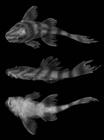ABSTRACT
A new species of Panaqolus is described from material from the Takutu River and the mainstem rio Branco. The new species is diagnosed from congeners by its color pattern consisting of dark and light bars on the body, bands on the fins, and with dots and vermiculations absent (vs. no bars in P. albomaculatus , P. nix , P. nocturnus , and P. koko , vs. fins unbanded in P. albomaculatus , P. dentex , P. koko , and P. nix , and vs. dots and vermiculations present in P. albivermis and P. maccus ). The new species is diagnosed from barred species of Panaqolus by its specific bar number and orientation and color pattern on its head, with bars oriented in a anteroventral-posterodorsal direction (vs. anterodorsal-posteroventral bars in P. gnomus ), having consistently 5 bars (n = 4) on the trunk that do not increase with size (vs. number increasing with size in P. purusiensis and vs. 6-12 in P. changae ), and the color pattern on the head of straight lines extending from posterior to the eye to the snout margin, splitting in the middle portion of the line in larger specimens (vs. small, dense reticulate lines in P. changae ). Biogeographically, we infer that the new species ancestrally originated in the Amazon river, dispersing to the Takutu River after the Amazon captured part of the Proto-Berbice.
Keywords:
Brazil; Guyana; Hypostominae; Takutu River

 A new species of Panaqolus (Siluriformes: Loricariidae) from the rio Branco
A new species of Panaqolus (Siluriformes: Loricariidae) from the rio Branco Thumbnail
Thumbnail
 Thumbnail
Thumbnail
 Thumbnail
Thumbnail


